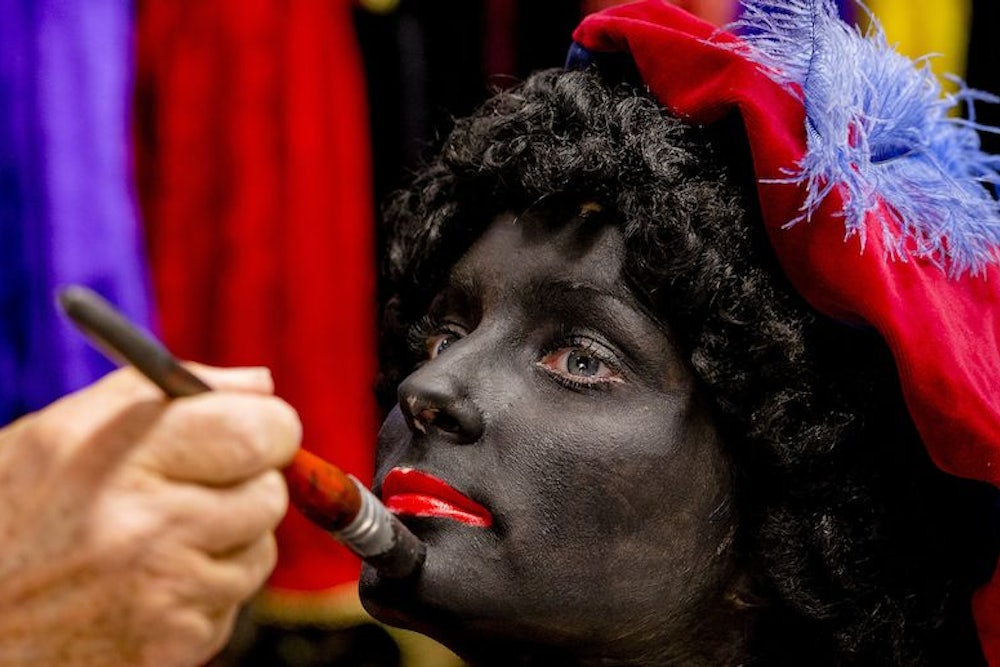My mother is from Holland and so, like every Dutch child, I celebrated Sinterklaas every year. According to Dutch tradition, Sinterklaas, or Saint Nicholas, arrives in the Netherlands from Spain each November for a visit that culminates in him delivering sweets and presents to well-behaved children on the night of 5 December. This year, Sinterklaas has sparked a debate so fierce that even the UN has become involved.
At the root of the controversy are Sinterklaas’s helpers, called the Zwarte Pieten, or Black Petes. “And do you know why Zwarte Piet is black?” I remember my grandma asking me. “It’s because he comes down the chimney to bring you your presents.” This is the story told to most children in Holland, but Zwarte Piet isn’t smeared with soot like Dick Van Dyke after a long day on set. His whole face is painted black and he has thick, painted-on lips, a black curly wig and thick gold hoop earrings.
It’s a wonder the tradition has survived so long. The Zwarte Piet debate has flared up annually for the past few years, but this year, the UN High Commission on Human Rights wrote to the Dutch government suggesting that the Sinterklaas celebrations could be racist.
Within days, a Facebook “Pietitie” in support of Zwarte Piet had attracted more than two million likes—in a country of 17 million. The leader of the Dutch far-right Freedom Party, Geert Wilders, tweeted that he would rather the UN were abolished than Zwarte Piet. Prime Minister Mark Rutte issued a statement saying: “Zwarte Piet just is black. I can’t change that.”
At the biggest Sinterklaas parade, held in Amsterdam on 17 November, small concessions were made on both sides to keep the peace. City authorities decreed that none of the Zwarte Pieten could wear earrings, because these are symbols of slavery. The several hundred protesters were asked to hold a silent protest, so as not to upset children. Journalists reported they weren’t able to interview any of the participating Piets, as they seemed to be acting under the instruction of a “PR-Piet”. At a parade in Groningen on the same day, armed policemen went undercover as Zwarte Pieten in case demonstrations turned violent.
No one likes their festive traditions tampered with – imagine trying to implement a countrywide ban on Christmas trees in the UK – but emotions over Sinterklaas run deeper. Most Dutch people identify themselves as inherently liberal, yet attacks on Zwarte Piet have been construed as an attack on Dutch identity – which is political dynamite, given the rapid growth of the far-right in recent years. The deputy prime minister Lodewijk Asscher’s insistence that “You can’t say the whole of Holland is racist” has struck a chord with many who feel aggrieved that a beloved childhood tradition has attracted such condemnation.
The problem is that even if a practice isn’t intended to be racist, it can still be hurtful, discriminatory and, yes, racist. Underneath the popular insistence that Sinterklaas is just a cosy children’s event, some worrying and ugly sentiments have come to light. Organisers hoping to hold the first ever “Rainbow Piet” parade, featuring multicoloured Piets, had to cancel their event in October after receiving death threats.
Viewed from outside, the Zwarte Piet debate seems baffling and surreal by turns. Yet the emotions it has exposed are very serious indeed.
This piece originally appeared on www.newstatesman.com.
